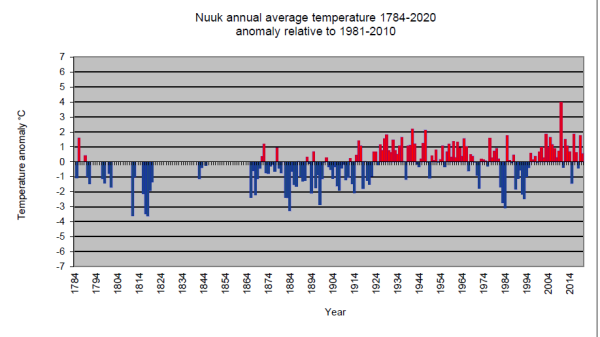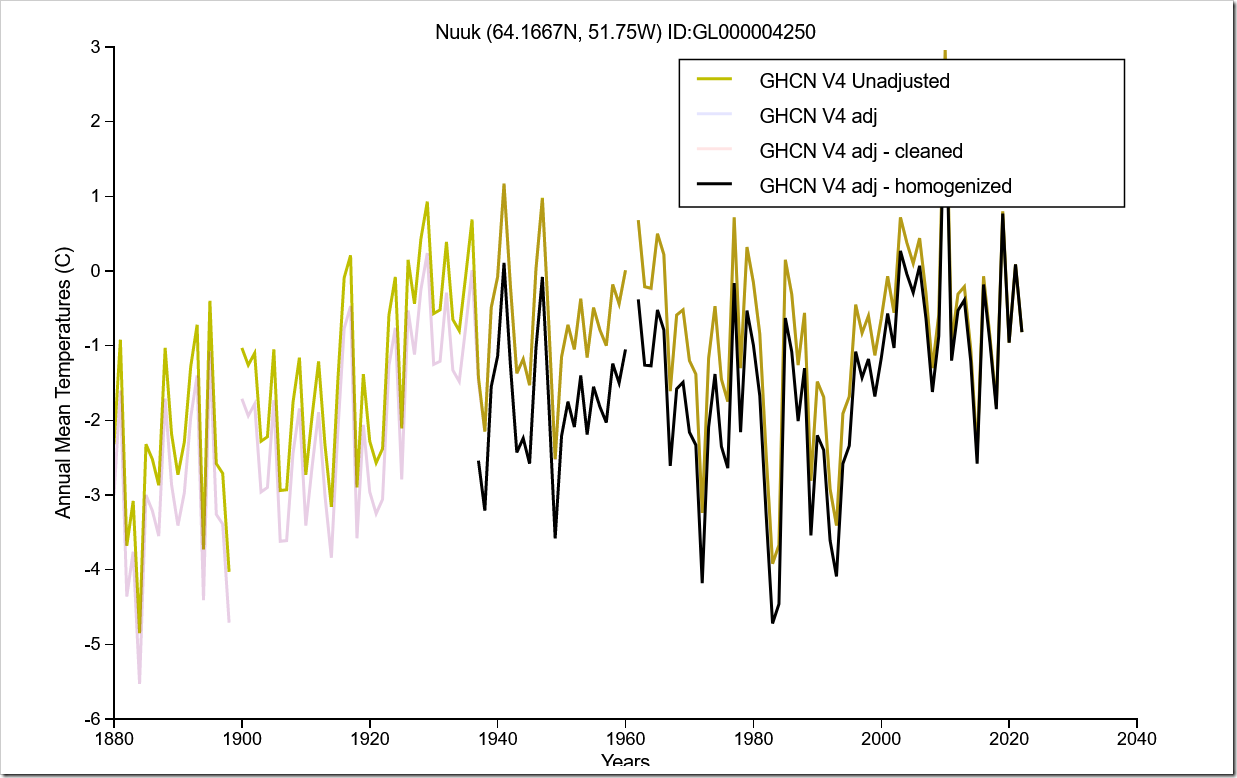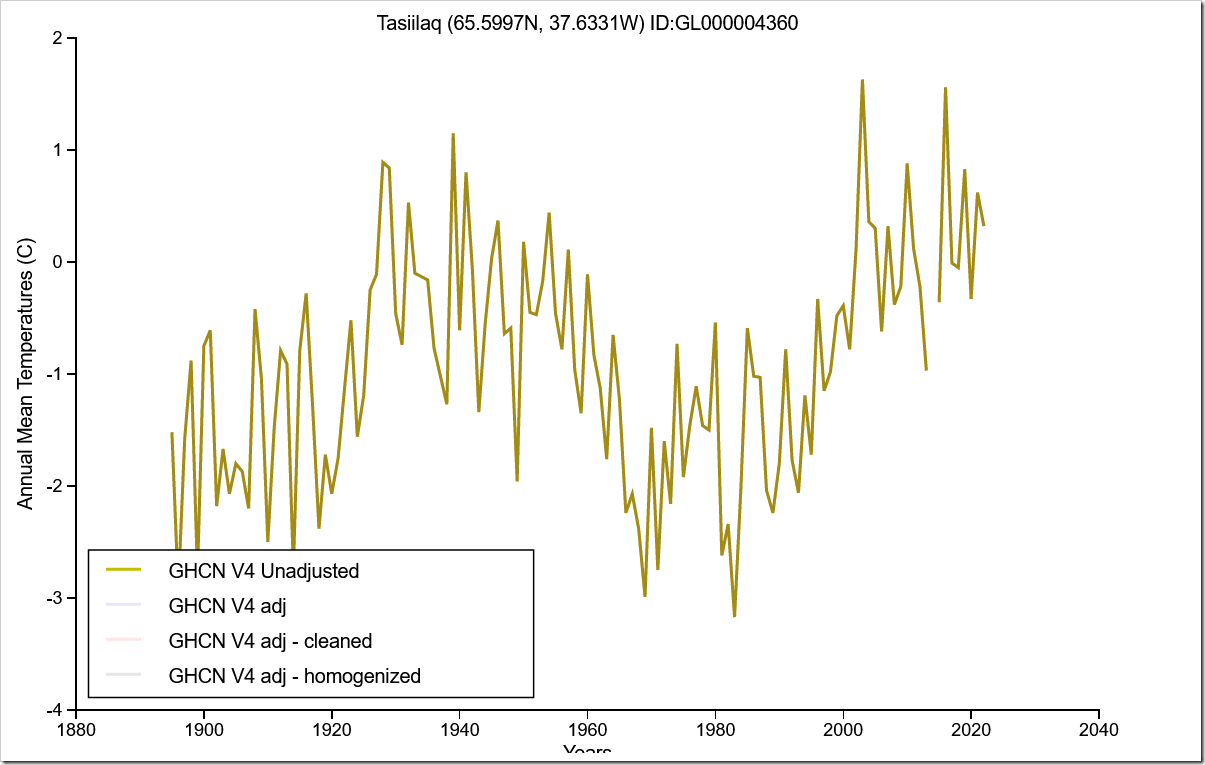Greenland Temperature Updates
By Paul Homewood

https://notalotofpeopleknowthat.wordpress.com/2021/06/12/greenland-temperatures-2021/
Every year I publish the latest Greenland temperature data from the DMI. Unfortunately they have not got round to updating it for 2021.
The data is of course extremely damning for the alarmist narrative about rising temperatures in the Arctic and Greenland meltdowns, as it shows that Greenland was just as warm in the 1930s to 50s as it has been in the last two decades, with the exception of that one warm year in 2010.
Maybe that is the reason for the withholding of the data for the last two years.
However we can still access the up to date numbers from GISS:
https://data.giss.nasa.gov/gistemp/station_data_v4_globe/
GISS publish both the unadjusted (ie actual) temperatures as well as their homogenised ones, which are used in their global temperature dataset.
The actual data follows the same trend as DMI, with temperatures as high around the 1930s and 40s. (The numbers are slightly different because GISS use meteorological years – Dec to Nov).
In contrast the tampered figures show considerable warming over the period.
Nuuk is on the west coast, and temperatures on the east side at Tasilaq show the same pattern:
It is worth noting that temperatures at both sites in 2021 and 2022 were below those 20thC numbers.
Comments are closed.


Would be interesting to see where in Nuuk and Tasilaq the temperature is actually measured, and how much development there has been in the vicinity since the 1940s. !
ps, I doubt that Nuuk looked much like this in 1940 !
https://i0.wp.com/tupilaktravel.com/wp-content/uploads/2016/10/aerial-view-over-the-city-of-nuuk-in-greenland.jpg?ssl=1
Warmer around the 1940s in other nearby places (pre-adjustment)
The Polar Portal graph of Greenland Ice Sheet meltwater measurements from the Watson River has also not been updated since 2018. At the time it was at a new low. One wonders if their instrumentation got swept away in a flood or perhaps this data is no longer considered a ‘safe and effective’ indicator of climate change?
‘Surface Conditions’ [Click tab for “Run Off”]:
http://polarportal.dk/en/greenland/surface-conditions/
But, but, but…..I thought we needed to “follow the science”????? Apparently not.
Not the science with facts and data, the siense wif purple hair and shouting, schoolboy error.
My point, exactly. I AM a scientist but pink hair or a sullen expression seems to trump my 3 degrees in plant taxonomy/ecology/ecosystems.
The vertical axis on the first graph is labeled ‘Temperature anomaly °C.’
The vertical axis on the 2nd and 3rd graphs is labeled ‘Annual Mean Temperatures (C).’
The data looks very similar. Is the first graph not actually the same as the other two? If not, what temperature is the base 0 for the anomaly graph?
The empirical observations support a warmer planet in the 1920s and 30s…
Drinkwater, 2006 wrote: “Ecosystem changes associated with the warm period included a general northward movement of fish. Boreal species of fish such as cod, haddock and herring expanded farther north while colder-water species such as capelin and polar cod retreated northward. The warming in the 1920s and 1930s is considered to constitute the most significant regime shift experienced in the North Atlantic in the 20th century.”
October, 1922: “The Arctic seems to be warming up. Reports from fishermen, seal hunters, and explorers who sail the seas about Spitzbergen and the eastern Arctic, all point to a radical change in climatic conditions, and hitherto un-heard-of high temperatures in that part of the earth’s surface.” …”With the disappearance of white fish and seal has come other life in these waters. This year herring in great shoals were found along the west coast of Spitzbergen, all the way from the fry to the veritable great herring. Shoals of smelt were also met with.”
The Nuuk site is in the airport, it featured in the Surfacestations survey having the Stevensonscreen a few yards from the aircraft and the asphalt which is cleared of snow.
Pretty sure that Nuuk Airport would have changed considerably since the 1940s
Phil Jones wrote a paper on the Greenland temperatures around 2005 and stated that the three consecutive decades from the 1930’s were the warmest on record. Is that still the case I wonder with the last 3 decades?
How on Earth do they justify homeginising those temperatures from the 1930s downwards? What reliable data show that the recorded data was SYSTEMICALLY higher than the actual data? If it was simply error, that would happen equally higher/lower so would cancel out in averages. So what made the records higher throughout? And what evidence do they have it was higher?
I think I see a temperature increase following the 1997-98 El Niño event.
Some folks predict another El Niño later this year. Worth watching.
Hubert Lamb reckoned the Arctic lost 10 – 20% of its ice from 1920 to the late 1930s based in part on the fact that the open season at the coalport in Spitsbergen (Svalbard) went from three months of the year before 1920 to over seven months of the year in the late 1930’s.
Physical proof of early 20thC warming!
Let’s see…if there had been a rise in the temperatures on Greenland would the DMI data be 2 years late? No, thought not.
Did the thermocouple burn out? /sarc